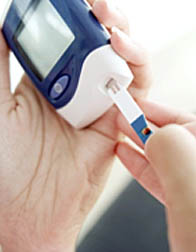This page has been archived and is being provided for reference purposes only. The page is no longer being updated, and therefore, links on the page may be invalid.
| Read the magazine story to find out more. |
|
|
Potential Indicators of Type 2 Diabetes Investigated
By Marcia WoodJuly 22, 2010
Though you may not have type 2 diabetes, you probably know someone who does. Agricultural Research Service (ARS) research physiologist Sean H. Adams is conducting studies to discover more about this complex disorder and especially to determine how better nutrition and regular physical activity might help prevent it.
Some of these investigations are yielding new indicators, called "biomarkers," of the disease. In time, physicians and other healthcare professionals might be able to use these indicators to identify, at an earlier stage, the children and adults who are at risk for developing this type of diabetes.
Also, nutrition scientists would be able to use the markers to monitor the progress of experimental nutrition- and exercise-based strategies designed for prevention.
One investigation led by Adams underscores the potential of natural compounds in the body, known as "fatty acylcarnitines," to serve as diabetes biomarkers. The scientists determined this after searching for telltale molecules in blood samples from diabetic and nondiabetic African-American women who volunteered for the research.
In some instances, levels of certain fatty acylcarnitines were almost 300 percent higher in the diabetic volunteers than in those without the disease. Apparently, the higher levels result from incomplete or inefficient oxidation of fat in the diabetic women, according to Adams. He's with the ARS Western Human Nutrition Research Center in Davis, Calif.
Incomplete oxidation of fats has already been associated with insulin resistance, a hallmark of type 2 diabetes. However, the study that Adams led adds detail to what he describes as the emerging picture of abnormal fatty acylcarnitine levels in blood as potential biomarkers of type 2 diabetes. The scientists documented their findings in a 2009 issue of the Journal of Nutrition.
Adams collaborated in the research with Daniel H. Hwang and John W. Newman at the center, and with co-investigators at the University of Alabama-Birmingham and Case Western Reserve University in Cleveland, Ohio.
The study is highlighted in the July issue of ARS' Agricultural Research magazine.
ARS is the principal intramural scientific research agency of the U.S. Department of Agriculture.

